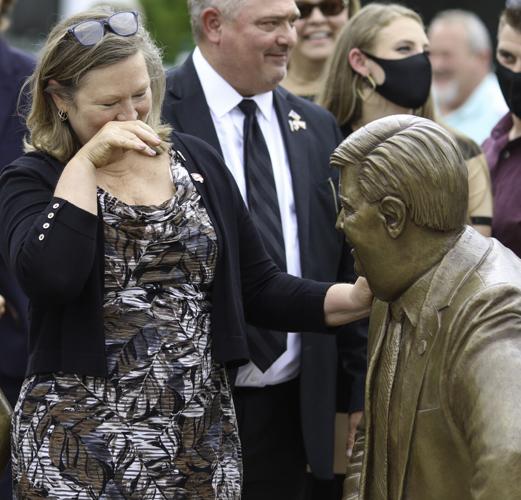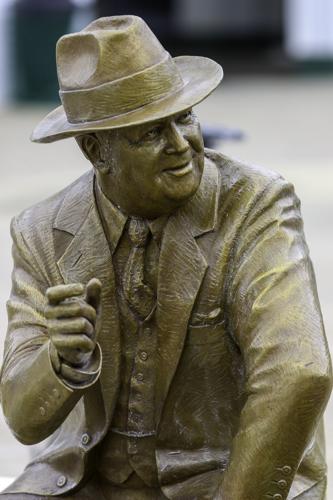LOUISVILLE, Ky. (WDRB) -- For only about a minute, maybe less, I had them to myself. Churchill Downs unveiled its long-awaited statue of longtime track president Matt Winn, the father of the Kentucky Derby as the event we know, and longtime vice president of communications John Asher, the greatest ambassador the race has known, on a cloudy Thursday morning.
The track was quiet. The invited guests, families of Asher and Winn, and track dignitaries, had left for a luncheon. The races were several hours from starting. A photographer from the track had taken his photos and left.
I had captured most of the images I wanted, and soon, others would wander in. But in this moment, standing off to the side of sculptor Raymond Graf's work, I snapped one more photo. In the background was the paddock clock, and for just that slice of time, just the snap of a shutter, it might as well have been standing still.
"I wonder what they're talking about," Churchill Director of Racing Publicity Darren Rogers said earlier as he put his arm on the shoulder of the statue of Asher, his old friend.
It's a strange thing to see someone you knew in the flesh cast in bronze. I can tell you it's a wonderful representation and a poor substitute.

Dee Asher, the wife of the late John Asher, looks at a statue unveiled of him at Churchill Downs on Sept. 16, 2021.
Certainly that was the experience of Dee Asher, John's wife, and his family. The track invited them, along with Winn's connections, to see the statue before a small crowd arrived.
"I'm not sure I have the words," she said. "It was emotional. Raymond Graf did a wonderful job. He really did capture John's spirit. We loved John. It was our family. But we did not know the enormity of the impact he had on everybody."
The surest bet you could make on this day at Churchill Downs, in answer to Rogers' question, was that Winn and Asher would be talking about Kentucky Derby history. Winn had made a great deal of it. Asher could not get enough of it.
Winn wouldn't recognize most of his surroundings, though he took over as the track's vice president and general manager in 1902. He would be its driving force until his death in 1949. In that time, he turned the Derby from a big event in Louisville to one of the biggest in sports. Winn led Churchill to embrace parimutuel wagering when bookmaking was outlawed in Kentucky, and established the minimum bet at $2 (down from $5), largely helping to save not only the Derby but the track itself. He courted the wealthiest, most successful thoroughbred owners and the most expansive media coverage with equal fervor. He decided to play "My Old Kentucky Home" before the race. He pushed and worked for bigger and grander crowds. He wanted the spectacle.
Under his watch, the Derby became front-page news around the nation. He understood its value as an event, beyond a horse race, and cultivated its high-society image as well as its common-man's appeal. If you place a $2 bet, tear up at Stephen Foster's song, put on fancy clothes or drink from a commemorative Derby glass, you have Winn to thank.
Maybe the only thing in the entire complex that Winn might find familiar today would be the iconic Twin Spires. But, as Rogers said, "His fingerprints are all over this place."
In Asher, on a bench across from him, he would've found a kindred spirit. Nobody loved the history of the Derby more than Asher, and it's doubtful anyone knew more of it. He spread the Gospel of the First Saturday in May to all corners of the country, first as a radio reporter for WHAS and then as a vice president of racing communication at the track.
Horse racing, as a sport, is very much about history.
As Churchill Downs went from an aging façade to a massive entertainment complex, it was Asher, more than anyone, who urged planners to cling to some of the tradition and mystique of the track.
"John Asher was the soul of Churchill Downs," former track president Kevin Flanery said when Asher died suddenly of a heart attack in 2018 at the age of 62. "And its conscience."

A statue of longtime track president Matt Winn, the father of the modern Kentucky Derby, and the late track Vice President for community relations, John Asher, a dedicated ambassador of the race, was unveiled Thursday, Sept. 16, 2021 at Churchill Downs.
Winn's right hand is raised, his forefinger and thumb just an inch apart, making a point. On his left hand is a ring featuring the profile of a thoroughbred. Asher holds a rolled-up program, slightly leaning in with a smile you recognize if you knew him, his 2015 Officer pin in his left lapel.
Two men, who more than anything knew the power of story — and the power of the Kentucky Derby's story — probably in the middle of one of a million stories that either could have swapped. Two men steeped in the history of the race, now cast under the Twin Spires, in their own way visible pieces of the race's history themselves.
Above, the Twin Spires stand as symbols. Below, the statues of these min sit, as the substance of an event that has helped define a state and its people. Across the way, a statue of Aristides, representing the horses that are celebrated in the race; and a statue of Pat Day, representing those who take the ride of a lifetime every First Saturday in May.
"This is unbelievable. He's where he should be," Dee Asher had said of her husband's statue. "There was never a person who came up to John that he didn't have time for."
Now, in the quiet moment, as I lowered the camera from my eye with the Spires and the men and the horse and the jockey and the paddock clock all in one sweeping view, it seemed right.
In this place, there will always be stories and history, and all the time in the world.
Copyright 2021 WDRB Media. All Rights Reserved.



